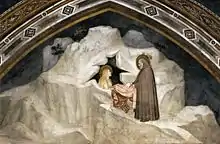Zosimas of Palestine
Zosimas of Palestine (Greek: Ζωσιμᾶς), also called Zosima, is commemorated as a saint in the Eastern Orthodox and Byzantine Catholic[2] Churches on April 4.
Venerable[1] Zosimus (Zosima) of Palestine | |
|---|---|
 | |
| Venerable (Monk) | |
| Born | c. 460 Palestine, Diocese of the East (Byzantine Empire) |
| Died | c. 560 Palestine, Diocese of the East (Byzantine Empire) |
| Venerated in | Coptic Orthodox Church Eastern Orthodox Churches Oriental Orthodox Churches Roman Catholic Church |
| Feast | 4 April |
Biography
Zosimas was born in the second half of the fifth century, during the reign of Emperor Theodosius II. He became a monk in a monastery in Palestine at a very young age, gaining a reputation as a great elder and ascetic. At the age of fifty-three, now a hieromonk, he moved to a very strict monastery located in the wilderness close to the Jordan River, where he spent the remainder of his life.[3][4]
He is best known for his encounter with Mary of Egypt (commemorated on April 1). It was the custom of that monastery for all of the brethren to go out into the desert for the forty days of Great Lent,[5] spending the time in fasting and prayer, and not returning until Palm Sunday. While wandering in the desert he met Mary, who told him her life story and asked him to meet her the next year on Holy Thursday on the banks of the Jordan, in order to bring her Holy Communion. He did so, and the third year came to her again in the desert, but he found that she had died and he buried her. Zosimas is reputed to have lived to be almost one hundred years of age.[6]
All that we know of Zosimas' life comes from the Vita of St. Mary of Egypt,[7] recorded by Sophronius, who was the Patriarch of Jerusalem from 634 to 638. Sophronius based his work on oral tradition he had heard from monks in the Land of Israel. This Vita is traditionally read as a part of the Matins of the Great Canon of Andrew of Crete, on the fifth Thursday of Great Lent.[8][9]
In the Western church this story was taken and used in the late medieval legend of Mary Magdalene, with Zosimas renamed as Maximin, as recounted in the Golden Legend and elsewhere. The fresco illustrated, by Giotto and his workshop in Assisi, shows this version.[10]
Notes
- In the Orthodox Church, monastic saints are referred to as "Venerable" (Greek: Όσιος, Hosios). The term is unrelated to the Roman Catholic term which describes a candidate for sainthood. For the Orthodox, Venerable saints are considered to be fully glorifed (canonized) saints.
- Such, Peter; Rabone, Richard (2009). Book of Alexander. Oxford University Press. ISBN 978-0-85668-864-5.
- Majeska, George P. (1984). Russian Travelers to Constantinople in the Fourteenth and Fifteenth Centuries. Dumbarton Oaks. ISBN 978-0-88402-101-8.
- Parry, Ken (2015-06-29). The Wiley Blackwell Companion to Patristics. John Wiley & Sons. ISBN 978-1-118-43870-1.
- Trüeb, Ralph M. (2015-09-02). The Difficult Hair Loss Patient: Guide to Successful Management of Alopecia and Related Conditions. Springer. ISBN 978-3-319-19701-2.
- Shaw, Roger (2012-10-09). The Book of Saints: A Day By Day Illustrated Encyclopedia. Weldon Owen International. ISBN 978-1-68188-719-7.
- A Vita is the life of a saint, often the earliest formal hagiography of that particular individual.
- Holweck, Frederick George (1924). A Biographical Dictionary of the Saints: With a General Introduction on Hagiology. B. Herder Book Company.
- England), Palestine Pilgrims' Text Society (London (1897). The Library of the Palestine Pilgrims' Text Society. Committee for the Palestine Exploration Fund. ISBN 978-0-404-04890-7.
- McGuckin, John Anthony (2010-12-15). The Encyclopedia of Eastern Orthodox Christianity. John Wiley & Sons. ISBN 978-1-4443-9254-8.